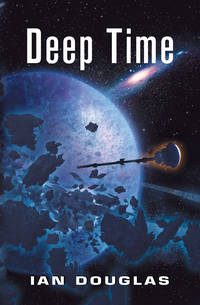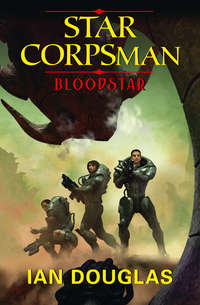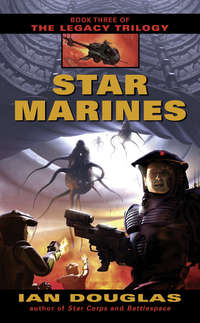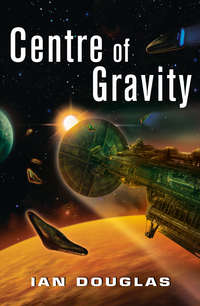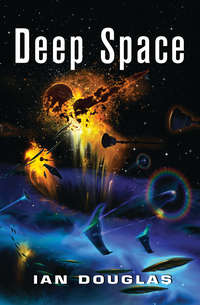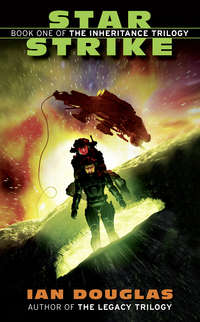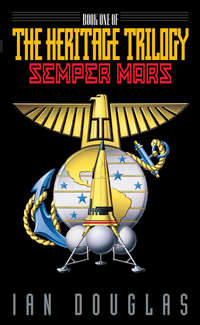
Полная версия
Bright Light
“Mr. President, this is something we must not leave to chance … or to human will and fallibility.”
Koenig scowled. “Sometimes, Konstantin,” he said slowly, “I get the feeling that you don’t trust humans.”
Geneva
Pan-European Union
2217 hours, GMT+1
It was raining and dark as the flier shrieked in over Burgundy, dropping swiftly from its cruising altitude of forty thousand meters, its outer surface reconfiguring from hypersonic mode to landing. “Going from sperm mode to turkey mode” was how fighter pilots described it, as the ship morphed from a sleek teardrop to a flattened, domed box with wings for landing. A former Navy pilot, Gray wondered if he would have to edit those memories sometime soon. They were a part of him, sure … but they were of damned little use now beyond pure nostalgia.
The lights of Geneva Spaceport glared up ahead, with the European capital’s urban sprawl delineating the black emptiness of Lake Geneva beyond. They touched down on a commercial pad, where an embarkation tube attached itself to the flier as the gravs were still spooling down.
Elena Vasilyeva, a tall woman in black with colorful abstract animations writhing over her face and hands, was there on the passenger concourse to meet him. “Captain Gray?” she said, extending a hand. “It was good of you to come on such short notice.”
It’s not like I had a whole lot of choice, he thought, but he kept it to himself and shook her hand. She was speaking Russian, but he heard the words in English as his in-head software translated them in real time.
“No problem,” he replied. “A pleasure. I’m sorry you had to stay at work so late in order to meet me.”
“It … what is the expression? It goes with the territory. This way, if you please.”
They traveled by mag-tube to the Ad Astra Confederation Government Complex, and a large meeting room a couple of hundred meters up, near the top of the tower. The space’s floor-to-ceiling windows looked out over the aptly named Plaza of Light and its titanic monument, Popolopolis’s statue Ascent of Man.
A number of other people were already present in the room, including several European military officers. Gray stopped at the threshold. “I was given to understand that this would be a civilian operation, Ms. Vasilyeva.”
“It is, Captain Gray,” a European Spaceforce admiral told him. “Operation Cygni, a joint European-American scientific and first-contact expedition to the star Deneb. However, as you must be aware, there are serious military and governmental implications to this mission.”
“Admiral Duchamp is correct,” an AI voice said in Gray’s thoughts. “In any event, we all wished to meet the man who would be commanding the expedition.”
“You could have done that in virtual reality,” he said.
In fact, the real reason for his transatlantic jaunt this afternoon had been bothering him quite a bit. With VR, people could meet in cyberspace, within AI-created realms with such resolution and fidelity to detail that it was quite impossible to tell illusion from reality.
“Perhaps,” the AI told him, “but we would not have known whether we were meeting the avatar or the actual person.”
“Nikolai is quite protective of us,” Duchamp told him. “He wanted us to get a good feel for the man who will be leading Operation Cygni.”
“ ‘Nikolai?’”
“For Nikolai Copernicus,” Vasilyeva explained. “An artificial intelligence housed here in Geneva analogous to your Konstantin.”
“A pleasure to meet you, Nikolai.”
“I am delighted to make your acquaintance. Until now I knew you only through back channels with Konstantin, and through intelligence reports and strategic analyses. To be frank, some of our people feared that you are a … I believe the Americanism is ‘cowboy.’ Shooting first, asking questions later.”
“And is that how you see me now?”
“Oh, most certainly not, Captain,” Duchamp told him. “We have all seen the reports of your encounters at Tabby’s Star. And many of us have been wondering why your senior staff would have retired you. It seems a poor use of a valuable asset.”
“Having met you, Captain,” Nikolai said, “and having spoken with you directly, I can unreservedly recommend that Operation Cygni proceed as it is currently organized, with our xenosophontological team under Captain Gray’s direct command.”
“So how about it, Konstantin?” Gray used a private channel to communicate with the AI without being overheard by the others. “I haven’t heard of this AI before.”
“Nikolai has only come on-line in the past few weeks,” Konstantin told him.
“A baby, huh? Can he be trusted?”
“As much as I can be trusted.”
Had that been sarcasm, Gray wondered? Or humor? Or a subtle rebuke? He found it difficult to understand what a super-AI was feeling—if feeling was the proper term—when he spoke with one.
“That’s not saying a great deal.”
Konstantin ignored the jibe. Gray wasn’t even certain that it was possible to insult the AI. “Nikolai,” Konstantin told him, “is several orders of magnitude faster, more powerful, and more compact than I. The Europeans wish to include a copy of him on the expedition to Deneb.”
“I’m not sure that’s such a good idea,” Gray said, transmitting on the group’s shared channel again. “The Omega virus, remember?”
“Nikolai was designed in part to be immune to Omega,” a sophontologist told him, “as well as to other potential e-threats.”
Gray wondered how any of them could be so certain of that, though. The Omega virus had been an alien software packet smuggled from Deneb back to Tabby’s Star … and it had apparently been responsible for the destruction of the Tabby’s Star civilization. Brought back to human space, it had been employed against the Rosette Aliens at Kapteyn’s Star, and evidently had been responsible for stopping the monumentally powerful invaders …
… at least for now. The Rosetters hadn’t been destroyed in the encounter by any means. As far as the xenosophontologists were concerned, they’d simply been forced to halt their advance toward Earth and actually notice the humans defiantly standing in their way.
“A copy,” Gray repeated. “Where? I mean, the Republic is going to have pretty limited running space for a full AI.”
“In this,” one of the civilian sophontologists said. She moved her hand in the air, summoning a hologram. “We call this the Helleslicht Modul Eins.”
Gray’s translator software told him the meaning of the German phrase: Bright Light Module One. The 3-D diagram floating in front of the woman was egg-shaped and, according to the listed dimensions, some three meters long and massing five metric tons.
“Dr. Marsh is a member of our xenosophontological team,” Vasilyeva told him. “But her specialty is advanced AI.”
“I see.”
“The HM-1’s internal matrix,” Marsh explained, “is essentially computronium—solid computing matter—with quantum circuitry of sufficient complexity and power to support Nikolai with plenty of room to spare.”
She sounded quite proud … and if she was even partly responsible for this device, she had every right to be. Artificial intelligences like Konstantin—in particular super-AIs, or “SAIs”—were resident within large computer complexes, usually underground and anything but mobile. Konstantin, for instance, had begun his existence in a subselene facility beneath Tsiolkovsky Crater, on the far side of the moon.
Using the far-flung Global Net, they could send independent parts of themselves anywhere within cislunar space. Pared-down copies of them, subsets of the larger and more powerful original software, could be resident within the electronic networks of starships or orbital stations. A sub-clone of Konstantin had made the passage to Tabby’s Star on board the star carrier America, and even smaller copies had been used to remotely contact the alien Dysonswarm intelligence there, and the uploaded minds called the Satori.
But that had been a fraction of what the original was capable of.
Gray wasn’t certain how massive the Tsiolkovsky complex was, but he knew it was big. If the Europeans had managed to build a computer that could run a similar SAI in a volume amounting to a few cubic meters, that was more than impressive.
It was a giant step forward for SAIs.
“So why does Nikolai want to go to Deneb?” Gray asked. He hesitated, then looked up at the ceiling. “I assume you do want to go, Nikolai?”
“Very much, Captain Gray,” Nikolai said.
“We cannot stress the importance of this expedition too much, Captain,” Duchamp added. “It is vital—vital—that we engage the Deneban civilization peacefully, to learn about them and their abilities, and perhaps to secure their aid in our confrontation with the Rosette Aliens.”
Gray shook his head. “I have to be honest with you, Admiral,” he said. “The Denebans may not be a good prospect for contact, let alone military aid. As best as we can determine, they utterly destroyed a technologically advanced culture at Tabby’s Star without even attempting to negotiate or open lines of communication.”
“We know that, Captain,” Duchamp said. “It was for that reason that we approached your President Koenig to request that we be included in Project Cygni. A copy of Nikolai, working with a copy of your Konstantin, offers, we believe, our best hope of establishing peaceful contact and technological help. It is unlikely that organic humans will be able to communicate in a meaningful way with such an advanced civilization.”
“But human oversight of the expedition is necessary,” Vasilyeva told him. “And when we learned that President Koenig was considering you as the expedition commander, we knew that there was hope.”
“Why?” Gray asked, genuinely baffled.
“Captain … we know too well that you can win battles, even wars. But what interests us is your ability to win peace.”
Chapter Two
31 January 2426
VFA-96, Black Demons
SupraQuito Yards
Earth Synchorbit
1018 hours, TFT
Through the vista opened by his fighter’s AI in his mind, Lieutenant Donald Gregory stared out into the tangle of orbital structures spread out before him. The SupraQuito Synchorbital was the largest of the human facilities in orbit over Earth, consisting of some hundreds of major stations and facilities strung together in a long, brilliantly lit arc.
The collection of structures was balanced on the Quito space elevator at an altitude of 37,786 kilometers, and a single orbit of the Earth took precisely twenty-four hours, which meant that the complex kept pace with the same spot on the turning Earth. From there, a slender tower reached down to its anchor point atop a mountain on Earth’s equator, and up into the black of space to the tethered asteroid that kept the whole assembly in dynamic tension. Four centuries earlier, synchorbit had been the parking zone for a swarm of unmanned communications satellites. Now it was one of three major communities in Earth orbit, with a permanent population of over sixty thousand and some thousands more each day traveling up or down the “E,” or arriving or departing on fleets of both interplanetary and interstellar ships.
The local sky, Gregory saw, was crowded with activity. The two badly damaged star carriers, Lexington and his own—or what used to be his own—America had been towed into position off the Navy yard, along with a couple of small asteroids. The two battered carriers were now almost obscured by swarming nanorepair ’bots busily eating away at the damaged hull surfaces, while simultaneously stripping the asteroids of raw material and bringing it across to the ships in steady streams.
We can rebuild our ships on the fly, Gregory thought. We can give them new life with this tech. But we can’t do anything for my squad mates.
Like Meg …
Lieutenant Meg Connor had been killed at Invictus, a frigid, ice-clad world out beyond the rim of the galaxy and 12 million years in the future. Gregory had lost his legs in that action. They’d grown those back for him … but nothing could bring back Megan.
Or Cynthia DeHaviland, killed in the hellfire of Kapteyn’s Star just a month ago.
“Tighten up, Demon Four!” the squadron’s CO snapped at him. “Belay the rubbernecking.” Commander Mackey sounded stressed.
What the hell do you have to be worried about? he thought, a bit petulantly, but he bit down on the words. “Copy,” was all he said. A moment’s inattention had let his Starblade fighter drift almost imperceptibly within the seven-ship formation, and with a thought he brought himself back into line. The spacelanes above and around the SupraQuito orbital facility were indeed crowded with ships large and small, construction tugs, intrastation transports, ship’s gigs, liberty boats, space-suited personnel on EVA, mobile repair shacks, and provisioning vessels. Theoretically, a lane had been cleared for the fighter squadron, but there was near-infinite opportunity here for a mistake.
And in space any mistake was likely to be expensive, fatal, or both.
At least Don Gregory was no longer suicidal. For a time after Invictus he’d been thinking about that a lot. The depression, at times, was overwhelming. His own in-head circuitry had urged him more than once to seek help, but he’d managed to put it off … and to avoid a mandatory checkup with the psych department. A down-grudge on his mental health would ground him … and might even get him kicked out of the Navy.
And now he thought he might see a better answer.
The seven fighters were moving at only eighty meters per second, a crawl against the scale of the titanic structures around them. They’d launched moments before from the America, followed a twisting route to stay clear of the nanoswarms and the small asteroid providing raw materials for the carrier’s repairs, and dropped into a long, slow approach to the main naval base dead ahead.
“There she is,” Lieutenant Gerald Ruxton called over the squadron channel. “Our new home!”
USNA CVL Republic was six hundred meters long, just over half the length of their former ship. Like America, though, she looked like an open umbrella, with a long, slender spine behind a dome-shaped shieldcap filled with water. In the shieldcap’s shadow, two modules rotated about the central keel, providing artificial gravity for the crew. A CVL, or light carrier, she had facilities to carry three combat squadrons of twelve fighters each, plus a number of auxiliary vessels, including a search-and-rescue squadron. VFA-90, a strike squadron called the Star Reapers, was also being transferred from America to the smaller carrier. In addition to VFA-96, the fresh-minted VFA-198, the Hellfuries, would be coming up from Earth later in the day.
After Kapteyn’s Star, the Black Demons could only muster seven fighters. They were supposed to be getting replacements up from Oceana, on Earth, but frankly, Gregory would believe that when he sat down with them in the ready room. Fighter losses during the past six months had been ungodly heavy, and they were having trouble recruiting and training replacements planetside fast enough to keep up with demand.
“VFA-96, this is Republic Primary Flight Control. You are cleared for final on Bay One, six-zero mps on approach.”
“Copy, Republic PriFly,” Commander Luther Mackey replied. “Bay One, sixty mps.”
Slowing sharply, the Starblade fighters fell into line ahead, moving in on the Republic from dead astern. Gregory was second in line, behind Bruce Caswell. He let his fighter’s AI cut his velocity and adjust his angle of approach; the landing bays on a star carrier were moving targets, rotating about the ship’s spine to create the illusion of gravity. Docking required more-than-human precision, and a slight upward bump of the thrusters just as the Starblade swept across the bay’s threshold. A feeling of gravity surged through Gregory’s body as the bay’s magnetic capture fields snagged his ship and brought him to a relative halt at the end of the deck.
“Demon Four,” a voice said in his head. “Trap complete. Welcome aboard, Lieutenant.”
Automated machinery grappled with his fighter, lifting it smoothly up through the overhead, making room for the next fighter in line behind him. The deck matrix molded about his Starblade for a moment, maintaining the vacuum in the landing bay as his fighter transitioned into pressure and the orchestrated bustle of deck personnel tending the incoming Starblades. Gregory’s cockpit melted open and released him, and he stepped out into the open.
“Welcome to the Republic, Lieutenant,” a woman with a commander’s insignia on her utilities said. Gregory felt her ping him as she accessed his in-head RAM and downloaded his personnel records and orders. “The ship will show you to your quarters. Debriefing at eleven hundred, Ready One.”
“Thank you, Commander.” Her name, he read through his in-head, was Sandra Dillon, and she was Republic’s ACAG, the assistant commander Aerospace Group. He opened a channel to the Republic’s AI and requested directions into the labyrinthine interior of the ship.
A light star carrier was considerably smaller than a monster like the America, but she still was an enormous vessel, with kilometers of internal passageways and compartments and a crew of more than two thousand. Junior officers quartered four to a stateroom; he found his berthing compartment and claimed a rack. Then he followed the ship’s directions to take him up to one of the ready rooms.
Gregory had been in the Navy for four years, now, and was an old hand at this. They would be getting the standard welcome-aboard talk, get to meet the ship’s CAG, and if they were lucky, find out something about the expedition to which they’d been assigned. That said, the setup for this mission was unusual: a Navy ship, with Navy personnel and three fighter squadrons … but with a civilian skipper and a load of double-dome civilian xenosophs. So that meant they were pulling first-contact duty.
Gregory didn’t much care one way or the other. He’d been there, done that, and been issued a brand-new pair of legs. At the moment he had only one question.
When the hell was he going to be able to get liberty? There was some very important business he needed to conduct ashore.
USNA CVE Guadalcanal
Orbiting Heimdall
Kapteyn’s Star
1213 hours, GMT
Captain Laurie Taggart floated into the bridge compartment of the escort star carrier Guadalcanal and pulled herself down into her command chair. “Captain on the bridge!” Commander Franklin Simmons, her XO, announced as her seat enclosed her lower body, gently restraining her in the ambient microgravity. In front of her, Lieutenant Rodriguez, the ship’s combat information officer, intently studied the repeater screens that partially surrounded him, and Taggart’s eyes widened as she glanced at them.
“What the hell is that?” she demanded. She’d received a “captain to the bridge” call moments earlier, but they hadn’t told her what the call was about.
“Don’t know for sure, Captain,” Rodriguez told her. “But it’s got to be the Rosies. Nothing else could work on that grand a scale!”
“Does the rest of the fleet see this?”
“They will when the signal reaches them, Captain. Transmission time … ten more minutes.”
Taggart stared into the screens a moment longer, then linked in with Nelly, the ship’s AI, opening the same channel in her mind.
She gazed into wonder …
Not for the first time Taggart questioned if these beings truly were the Stargods of her religion. She’d drifted away from the old beliefs lately, but it was impossible to feel that inner stirring of awe and not at least wonder.
They were in orbit over an Earth-sized moon of the gas giant Bifrost. Heimdall was a barren, desolate world now, though it had given rise to intelligent life billions of years in the past. For the past 800 million years or so, it had been the site of the so-called Etched Cliffs, a super-computer network carved into solid rock and spanning the world. Several alien species had vanished into that network, living digital lives within a virtual universe of their own making.
Those uploaded minds, uncounted trillions of them, were gone now, devoured by the Rosette entity—“the Rosies,” as Rodriguez had called them. For weeks the world had been utterly dead and empty. But now …
It looked like aurorae, slow-moving bars and circles of pale blue-green light, but the patterns were far too regular and organized to be natural emissions within the local magnetic field. They were emerging, it looked like, from the primary Etched Cliffs site, but expanding second by second with bewildering speed and complexity to engulf the world of Heimdall.
The Rosette entity had created large numbers of geometric constructs in open space, but the structures had vanished after the Battle of Heimdall. Navy xenosophontologists had assumed that the aliens had withdrawn.
Evidently, Taggart thought as she studied the phenomenon, they had not.
“Helm,” she said.
“Helm, aye, Captain.”
“Take us out of orbit. Come to one-one-five minus one eight, five-zero kps.”
“Come to course one-one-five minus one eight at fifty kps, aye, aye.”
She didn’t know what was going on down there, but she wanted her ship well clear of it, whatever it was.
Her ship. Laurie Taggart’s military career had taken some sudden and unexpected shifts in vector over the past few months. She’d started off as senior weapons officer on board the star carrier America … but then she’d received a new assignment as Exec on board America’s sister ship, the Lexington. From there, she’d volunteered for TAD—temporary attached duty—as skipper of the Lucas, a Marine transport and stealth lander, and then had returned to take command of the Lady Lex when Captain Bigelow had been killed.
She’d been the one who’d brought the crippled Lexington home.
Of course, there was no way the Navy Department was going to let her keep that billet. She was far too junior, too low on the Navy’s rank hierarchy to skipper the Lexington. Upon reaching SupraQuito, though, she’d received a field promotion to the rank of captain and been given command of the light carrier Guadalcanal.
She suspected that Trev—her lover, Captain Trevor Gray—had made the recommendation for her promotion, but he’d refused to confirm or deny her accusation. Instead, he’d snuggled her in close and merely whispered, “Hush. You’ve earned it.”
Now she just hoped she could keep what she’d earned. The light show was engulfing the entire globe of Heimdall now and reaching far out into space as well.
“Captain?” Lieutenant Peters, on sensor watch, called. “We’re getting solid returns now. Fireflies.”
“Shit …”
Fireflies referred to small, autonomous objects, ranging from dust specks to a few meters across in size, that seemed to be associated with the Rosette Alien structures. They flew in unimaginably vast swarms, could fit themselves together into solid components, or they could destroy a starship simply by ramming into it at high velocity. Fireflies were believed to be part of an enormous swarm intelligence numbering in the hundreds of trillions and providing the underlying computronium matrix for the Rosette intelligence.
What, she wondered, was the best call, here? Stay put and observe? Rejoin the rest of the Kapteyn’s Star flotilla out at Thrymheim, the system’s outermost planet some twelve light-minutes distant? Probe the bewildering tangle of light structures now unfolding across local space? Launch Guadalcanal’s fighters?




